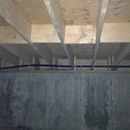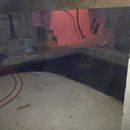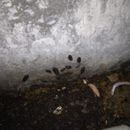Is sprayfoam or rigid foam a logical choice?
I’ve read a few of the articles on how to properly design an unvented crawlspace, but couldn’t quite find something that fit the scenario of the crawlspace under my apartment. So here goes.
I’m currently renting an apartment, while in school, that is located just feet from a small lake. Upon conducting general UA calculations for total heat loss in the building (as a project for a class), I noticed a few things of concern in the crawlspace below the first floor, and am looking for some advice. Allow me to explain the circumstances.
Because this house is located just off the water, I do not believe that the foundation travels any more than a couple of feet below grade due to the water table. It also appears that the landlord decided to pour a slab of concrete, only to stop about 3/4 of the way across (See photo), revealing very wet gravel and earth which is due to the water table. The perimeter foundation walls are insulated with about 1.5 inches of XPS (exterior) and there is currently no insulation of any sort in the floor joists. Again the crawlspace is unvented, and is also unconditioned, but there are no mechanical systems within the crawlspace. There is just a propane line, water main, and sewage drain.
Would it be logical to insulate the floor joists then with closed-cell spray foam or perhaps rigid foam? Due to the amount of heat loss from the above space into this crawlspace? Being mindful of the pressure and thermal boundaries. My concerns are the excessive moisture already in the foundation and crawlspace as well as the XPS on the perimeter foundation walls. Obviously some sort of vapor retarder should be implemented as well. Any thoughts? Please see the attached photos as it may help you understand my explanation Thank you!
GBA Detail Library
A collection of one thousand construction details organized by climate and house part













Replies
Mike,
Where are you located? How cold, hot, humid does it get?
Any history of flooding up to the house?
Oops I should've mentioned this prior. I'm located in New Hampshire, where we can see temperatures down to -20 in winter and as high as 95+ in summer. The area is a fairly humid climate with warm humid summers and cold wet winters, and fairly uniform precipitation year round. I do not know of any flooding history up to the house directly, as it is a newly constructed building within 3 years or so. However, the lake has been known to rise a couple of feet higher than average when there is consistent precip. for several days.
Mike,
1. You're in New Hampshire, where plumbing pipes (your water supply line) will definitely freeze in a crawl space unless the crawl space walls are insulated. So the builder was correct to insulate the exterior of the crawl space walls and leave the joist bays empty.
2. The joist bays and subfloor look nice and clean -- no mold. That's good.
3. All of the usual drainage rules apply -- slope the grade on the exterior, install roof gutters and conductor pipes if necessary, and install a sump and sump pump if there is standing water in the basement.
4. Cover the soil and the slab with 6 mil (or thicker) polyethylene. Then pour a new rat slab if the owner can afford it; otherwise, tape the seams of the poly and hold it down with bricks or rocks.
5. Don't insulate the joist bays.
Great thanks for the response. My only concern then is all of the heat loss to that crawlspace from the floor above. Are the joist bays left open solely for the purpose of allowing some heat to the crawlspace so the pipes don't freeze? I know the owner has installed the electric pipe heating wrap over all of his water lines within the crawlspace, would that make a difference? To me, it just seems like something should be further insulated so that there isn't so much heat loss. It seems as if the heat is constantly running and the floors are always cold as the crawlspace, right now, is somewhere around the upper 30's in temp. Forgive me for I'm still learning a lot about most of this and thanks again!
Mike,
If your crawl space temperature is in the upper 30s, then you have an air sealing problem. The first step to correct this problem would be to perform air sealing work in your crawl space.
Here's an article with tips for air sealing a crawl space or basement:
http://www.finehomebuilding.com/design/departments/energy-smart-details/air-sealing-a-basement.aspx
Once you have completed the air sealing work, the temperature in your crawl space will not be in the upper 30s any more (especially right now, when the outdoor temperature is between 20°F and 35°F).
After the air sealing work is complete, the owner could always install closed-cell spray foam on the inside of the crawl space walls to raise the R-value of the walls. That would further reduce heat loss to the exterior.
Sounds like a 3 season camp. Nice thick carpet and great slippers?
I have insulated the floors of camps and protected pipes similar to mobile home situations.
Get your favorite contractor to give you some choices. Eyes onsite may get you to where you want to be.
Thanks for that link. I guess it seems somewhat obvious now to me that the cavities at the joist headers are totally uninsulated and creating a huge thermal bridge there. I didn't even take notice in the image above before. That should make a huge difference in the temperature in the crawl space and ultImately in the heat loss through the first floor.
Mike,
Well, it depends. You said that the exterior of the crawlspace walls are insulated with rigid foam.
Some builders insulate rim joists on the exterior with rigid foam, so the rim joists may already be insulated. However, if your guess is correct, and the rim joists aren't insulated, they they definitely need some rigid foam or spray foam.
Martin,
I just took a look a few minutes ago in a somewhat accessible area and saw no signs of exterior rigid foam on the exterior of the rim joists, so insulating the perimeter cavities sounds like the first move. Thanks for your help!